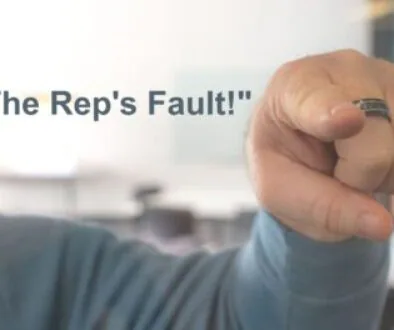When Healthcare Providers Underestimate Their Inefficiencies and Standards of Care
Medical sales professionals often joke about the big egos that doctors and other health care providers have, but of course, a healthy ego is necessary to make decisions and provide treatments that affect people’s health and ultimately their lives. If you’ve been in healthcare sales for any period of time, you’ve no doubt seen how the associated big ego often obscures reality from fiction, or that which healthcare providers choose to believe is true. Most doctors, for example, are satisfied with the level of care and the therapies they offer and seldom see a need to consider any changes. Why is this? For one thing, doctors ten to shun change, unless there is a problem.
If what they’re doing is working, who the heck is some salesperson to suggest they could be doing better. If it ain’t broke, don’t fix it. The enemy of good is better, etc. We can recite the sayings of closed minded thinking all day. But let’s get to the root of the cause…
Healthcare providers don’t always know what they need because often, they don’t perceive any problems. Or they tend to look at their problem and situation from a limited perspective, much as people did at the turn of the century before the automobile was invented. Henry Ford said if you asked people what they wanted to improve transportation before the automobile was invented, they would have said, “Faster Horses.” Again, the point is that your healthcare customers don’t always know what they need because they often don’t see the problem or are unfamiliar with new and innovative solutions. And of course, all doctors, as men and women of science, always want to learn about new ways to treat their patients, right? If only it were true.
Let me give you an example of a situation where healthcare providers underestimate their inefficiencies. I recently delivered a workshop for a medical device company that sells a product that provides instantaneous results to doctors in a clinical situation. You’ll find that doctors are keenly aware of the value of their time and don’t like to waste any of it, right? These doctors perform a procedure where a specimen is sent for analysis. They wait for results before they finish the procedure. The average wait time to receive results is 20 to 30 minutes. When doctors are asked how long the wait time is, most say 5 or 10 minutes. It is actually twice as long, but due to their busy minds and rote processes, most are unaware. When salespeople set up evaluations and measure the delay in real time, the doctors are dumbfounded. These doctors don’t even know that they have a problem. And they’re not aware of a solution until and unless a salesperson shows them how to save up to 30 minutes with each patient. Not only does the doctor benefit, but the patient benefits tremendously.
Almost every doctor who evaluates the referenced product wants it once the benefits are experienced. But two things stand in the way of widespread improvement. First again, is that healthcare providers don’t always know what they need. They think they just need faster horses—and this is demonstrated by doctors frequently asking everyone to do their jobs faster. They almost always blame someone else for slowing them down when it’s their commitment to the status quo that is the biggest enemy. Aside from declining reimbursement and a need to see more patients to survive financially, the doctors and other healthcare professionals you sell to will always be happy with what they’re doing unless they realize that there is a problem or a better way.
That’s where you come in. You’re a medical sales professional.
You sell, yes, but you also serve and educate. Your job is to get your customers to open their eyes and help them see that their worlds are not perfect. Your value is not in your ability to sell a product, but in the keen insight you provide that identifies a problem before you position a solution. Ultimately, you help them to elevate their standard of care, eliminate inefficiencies, and save money – not to mention improving the outcomes for their patients which should always be the number one goal.
Is doing what I described easy? Of course not! If it were easy, everyone would be in medical sales. That’s why you get paid the big bucks. You’re a disrupter. You bring a dose of reality, even a dose of pain. But you also bring the solution that improves lives. That’s a pretty cool job to have.
Go disrupt your customer’s day. They’ll thank you for it…eventually. And you’ll sleep soundly knowing you’ve made a difference for the customer and the customer’s patients. Oh yeah…you’ll also feel good about depositing those increasing commission checks.



